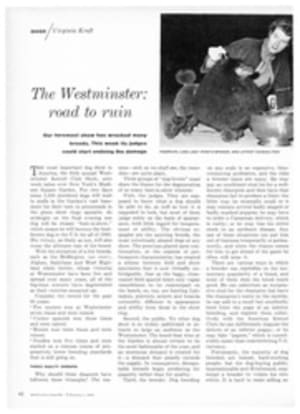
Eating high
The basic appeal of skiing is due, of course, to the joy the human race has always felt in sliding downhill as fast as possible. But after a few winters in the Swiss Alps I see that there is a wide range of secondary pleasures attached to the sport.
For the nature lovers, offended by the noise and bustle of the city, there is the silent grandeur of snow fields and inaccessible peaks. For the white-collar slaves of modern business, to whom the city is the loneliest place in the world, there is the chatty crush of the téléphériques carrying full loads up the slopes on a holiday weekend. For the Germans there is the opportunity to get broiled deep-red by the sun. For the English the delicious risk of breaking their necks. For the Italians there is the exhilaration of traffic accidents at dizzying speeds without the usual impersonal paraphernalia put out by Alfa Romeo and Lancia to come between them and their victims. For the French there is the happiness of having an excuse to go off for a few days without their wives—or their husbands. For girls with good figures there is the praiseworthy occupation of showing off their good figures in skintight, brilliantly colored ski pants. For ladies with diamonds there are the glittering nightly ceremonies of the Palace Hotel in St. Moritz. And for everybody there is the sense of health and well-being that comes with innocent exercise and mountain air. And since health and appetite go inevitably together, not the least of the pleasures associated with skiing is the pleasure of eating.
People seem to eat more voraciously and with greater enjoyment in a ski town than anyplace else in the world, with the possible exception of a football training table. There is nothing like four hours of working up and down a wintry mountainside to make you feel that you have earned a large, heavy lunch. You can almost feel the calories burning blithely away and, as you pull in your belt notch by notch on each successive morning, you have none of the usual city guilt when you pile into the fried potatoes or take a second helping of spaghetti. And when gluttony is pursued at a table set out in the open, with a blazing sun beating down on the piled snowbanks, eating takes on a purity of tone, a noble dimension that even the most glorious of restaurants rarely attain.
The Italian cuisine which, with its savory pasta and its rich taste of olive oil, is the despair of the sedentary 20th century man, seems to have been designed from the beginning for the job of keeping meat on a skier's bones and a song in his heart when the wind blows and the blizzard howls in the upper reaches of the Alps.
My feeling about this no doubt comes from the fact that for the last seven years we have had as a cook an Italian lady who keeps emerging from the kitchen with a steady stream of such offerings as fettuccine alla romana, bubbling platters of cannelloni, spaghetti alla bolognese, gnocchi made with polenta, pizzas prepared with fresh mozzarella cheese, which makes all the difference in the world, chicken alla diavola, which is grilled, highly spiced, over an open wood fire, beefsteak alla fiorentina, which is sirloin steak soaked in olive oil and garlic and then grilled over an open wood fire. With a fair admixture of salads and an open-minded attitude toward such Americanisms as Christmas turkeys and baked Virginia hams, and such local items as live brook trout, sausage and a delicacy called Bündnerfleisch, which is beef dried and cured in the wind and cut into paper-thin slices, an Italian cook can manage to combine, in a high-altitude package, the best of several possible culinary worlds.
A fresh wine called Veltliner, which comes from one of the valleys on the Italian border, goes very well with most of the Italian dishes, especially the pasta, and if you're thirsty and the sun is warm, it is quite all right to stick the bottle in the snow and chill it before you drink it. Swiss wines have been overshadowed by the magnificence of the neighboring vineyards of France, but the white wines, the Aigle, the Fendant, the Johannisberg, the Dézaley, are all fine drinks, and no less a man than James Joyce, who finished his days in Zurich, drank them with pleasure and praised them in straight, simple English.
Articles like this usually end with the recipe for some favorite dish of the writer's. I have only one recipe—but it has the advantage of being easy to follow and impossible to botch. Here it is:
SKIERS' SPECIAL
Find one light-fingered Tuscan cook. Put her in the kitchen. Stay out of the kitchen yourself. Mix yourself a drink. Sit down and wait for dinner.
Just make sure the snow is going to be good the next day, because it will take all day to work it off.
PHOTO
TONI FRISSELL
SKIERS' LUNCHEON: At a table set up in winter sunshine outside his chalet in the Swiss village of Klosters, Irwin Shaw presides over a festive meal with family and guests, after a morning on the nearby ski slopes. At his right is his wife Marian, their son Adam and (in straw hat) guest Barbara Legendre. Other guests, across the table, are Mr. and Mrs. Clem Brown and (at extreme right) F. M. Bacon III.

